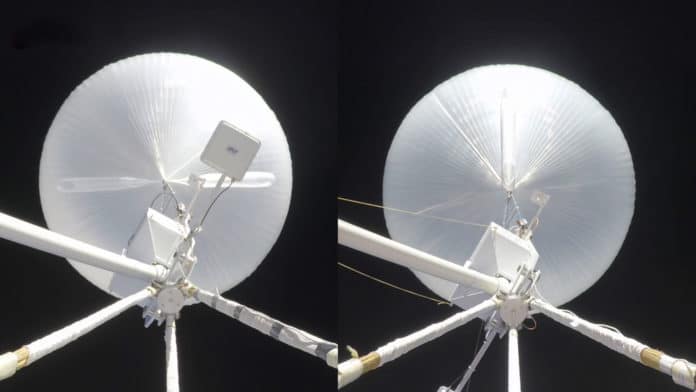The European Space Agency (ESA) has completed the first successful high-altitude drop test of the ExoMars mission parachute, which will be the largest parachute set to ever fly on Mars. Both the first and second-stage parachutes have now successfully flown this year, ensuring the ExoMars mission is on track for launch in 2022.
A pair of high-altitude drop tests took place in Oregon on 21 November and 3 December as part of the ongoing parachute testing to ensure the safe delivery of the ExoMars Rosalind Franklin rover and Kazachok lander to the surface of Mars in June 2023. The 35-meter-wide subsonic parachute will be the second parachute to deploy during the ExoMars descent modules final moments before touchdown.
“Both parachutes deployed and flew beautifully,” says Thierry Blancquaert, ESA Exomars program team leader. “We maximized the lessons learned from all previous tests, and with this double success following the impressive first stage parachute deployment earlier this year, we’re really on the road to launch. We have demonstrated we have two parachutes to fly to Mars.”
The team will continue to test to verify the robustness of the final selection of parachutes, with more high altitude drop test opportunities possible in 2022 for both the first and second stage parachute.
The ExoMars mission is a collaboration between the ESA and Russia’s space agency, Roscosmos. The ESA-Roscosmos ExoMars mission is scheduled for launch in September 2022. After a nearly nine-month interplanetary cruise, a descent module containing the rover and platform will be released into the Martian atmosphere at a speed of 21,000 km per hour. The lander will be able to slow down thanks to a thermal shield and its two main parachutes. The 15-meter-wide first stage main parachute will deploy while the descent module is still traveling at supersonic speeds, and the 35-meter-wide second stage main parachute will deploy at subsonic speeds. A retro rocket propulsion system will then be triggered 30 seconds before touchdown.
Adjusting and testing the ExoMars parachutes has been a priority following a series of unsuccessful drop tests in 2019 and 2020.
The parachutes are just one element of this complex mission, which, after launch, will see a carrier module transport the rover and surface platform to Mars inside a descent module. Significant progress has been made across many areas of the mission in the last months, as the functional testing phase draws to a close and attention shifts to the launch campaign in Baikonur.
The ExoMars mission will launch on a Proton-M rocket with a Breeze-M upper stage from Baikonur, Kazakhstan, in the 20 September – 1 October 2022 launch window. Once landed safely in the Oxia Planum region of Mars on 10 June 2023, the rover will drive off the surface platform, seeking out geologically interesting sites to drill below the surface to determine if life ever existed on our neighbor planet. The ExoMars program also includes the Trace Gas Orbiter, which has been orbiting Mars since 2016.
